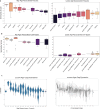This is a preprint.
The Dissipation Theory of Aging: A Quantitative Analysis Using a Cellular Aging Map
- PMID: 40321941
- PMCID: PMC12047931
The Dissipation Theory of Aging: A Quantitative Analysis Using a Cellular Aging Map
Abstract
We propose a new theory for aging based on dynamical systems and provide a data-driven computational method to quantify the changes at the cellular level. We use ergodic theory to decompose the dynamics of changes during aging and show that aging is fundamentally a dissipative process within biological systems, akin to dynamical systems where dissipation occurs due to non-conservative forces. To quantify the dissipation dynamics, we employ a transformer-based machine learning algorithm to analyze gene expression data, incorporating age as a token to assess how age-related dissipation is reflected in the embedding space. By evaluating the dynamics of gene and age embeddings, we provide a cellular aging map (CAM) and identify patterns indicative of divergence in gene embedding space, nonlinear transitions, and entropy variations during aging for various tissues and cell types. Our results provide a novel perspective on aging as a dissipative process and introduce a computational framework that enables measuring age-related changes with molecular resolution.
Keywords: aging; dissipation; dynamical systems; language modeling; multimodal foundation model; single-cell RNA sequencing.
Figures





Similar articles
-
Symplectic Foliation Structures of Non-Equilibrium Thermodynamics as Dissipation Model: Application to Metriplectic Nonlinear Lindblad Quantum Master Equation.Entropy (Basel). 2022 Nov 9;24(11):1626. doi: 10.3390/e24111626. Entropy (Basel). 2022. PMID: 36359716 Free PMC article.
-
Multimodal Learning for Mapping the Genotype-Phenotype Dynamics.Res Sq [Preprint]. 2024 May 16:rs.3.rs-4355413. doi: 10.21203/rs.3.rs-4355413/v1. Res Sq. 2024. Update in: Nat Comput Sci. 2025 Apr;5(4):333-344. doi: 10.1038/s43588-024-00765-7. PMID: 38798675 Free PMC article. Updated. Preprint.
-
Curry-Yorke route to shearless attractors and coexistence of attractors in dissipative nontwist systems.Chaos. 2021 Feb;31(2):023125. doi: 10.1063/5.0035303. Chaos. 2021. PMID: 33653060
-
New Possibilities for Evaluating the Development of Age-Related Pathologies Using the Dynamical Network Biomarkers Theory.Cells. 2023 Sep 17;12(18):2297. doi: 10.3390/cells12182297. Cells. 2023. PMID: 37759519 Free PMC article. Review.
-
Modeling of dynamical systems through deep learning.Biophys Rev. 2020 Nov 22;12(6):1311-20. doi: 10.1007/s12551-020-00776-4. Online ahead of print. Biophys Rev. 2020. PMID: 33222032 Free PMC article. Review.
References
Publication types
Grants and funding
LinkOut - more resources
Full Text Sources
